New Mars Forums
You are not logged in.
- Topics: Active | Unanswered
Announcement
#1 2016-01-02 14:51:21
- Tom Kalbfus
- Banned
- Registered: 2006-08-16
- Posts: 4,401
New New York
Imagine a city on Mars that looks like this: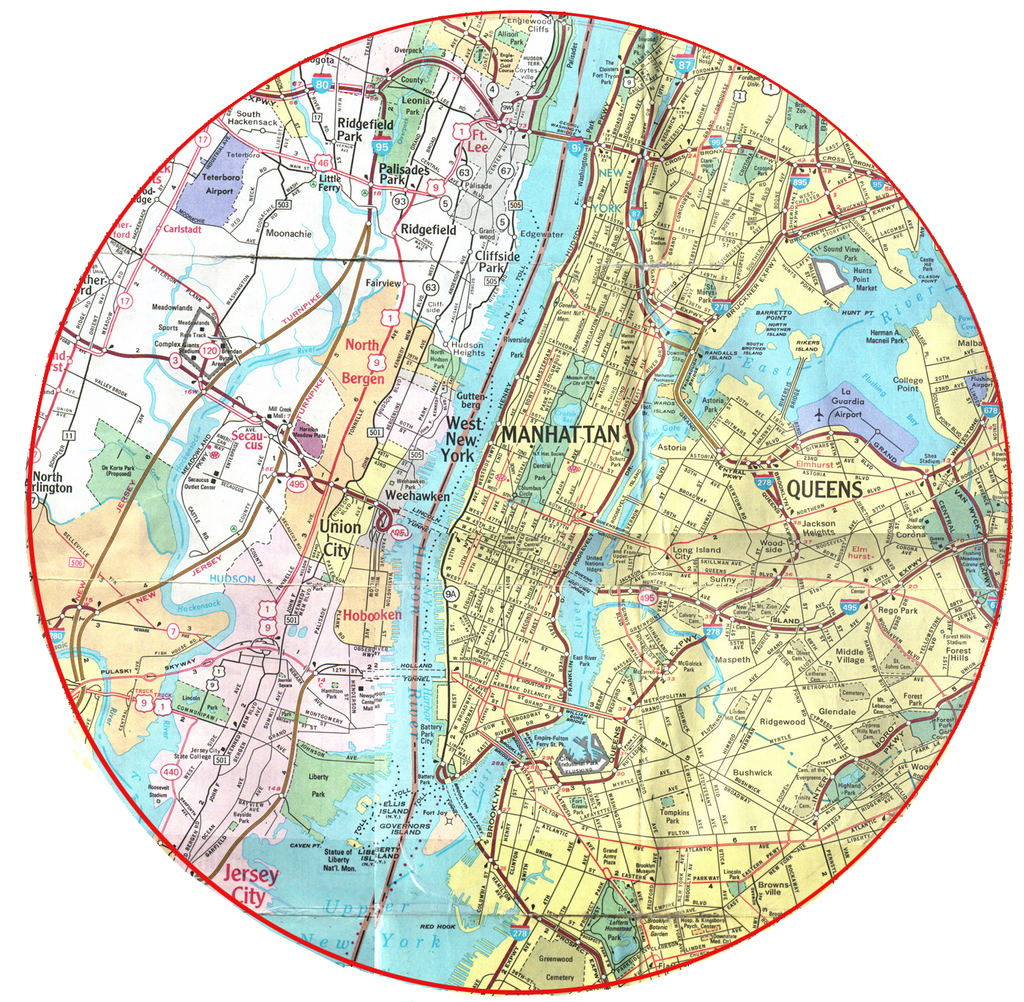
We'll call it New New York, it is basically a copy of an 8 mile radius map of New York City 1:1 scale on Mars with all the buildings, roads, and infrastructure copied.
The city is situated in a crater on Mars like so: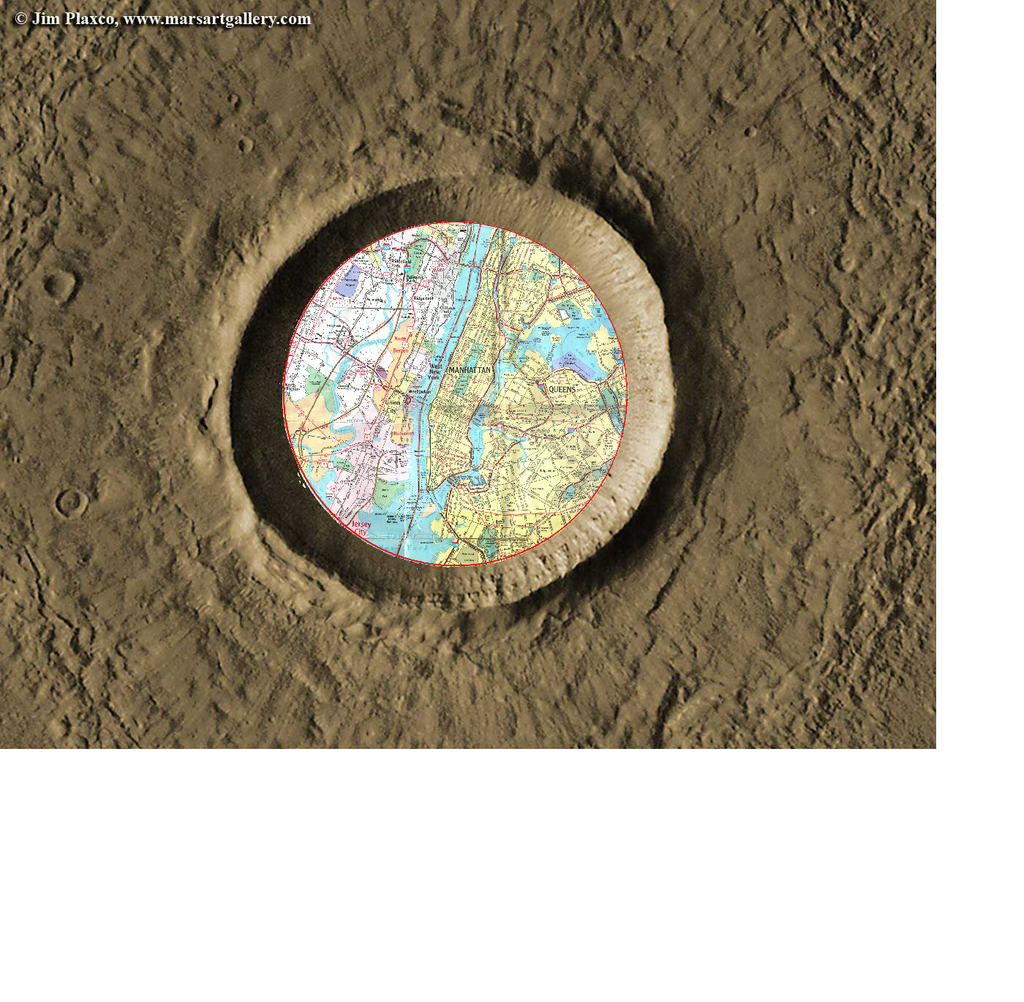
This diagram illustrates how the atmosphere of the city is retained: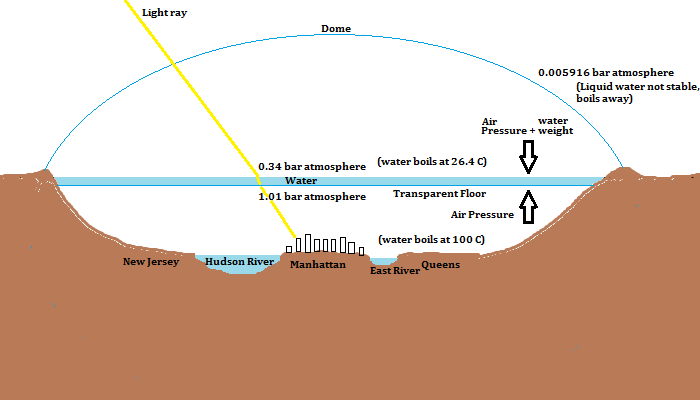
Just an errata not, the air pressure above the intermediate water layer is 0.034 bar, not 0.34 bar as the diagram states.
The city is situated to the east of Marineris Vallis on the equator.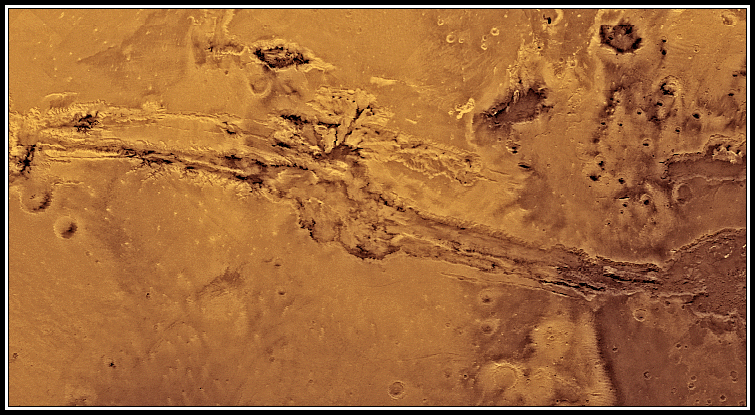
The city is constructed by robots in 2067, the robots are quite advanced by todays standards, in fact they can do all the work themselves without human supervision.
The assumption is that space travel is common place rather than newsworthy.
So the question I would raise is what would this city need that is unique to the environment of Mars, if it is to support 8.49 million people? Probably some agricultural domes located elsewhere. The fake Hudson and East River could be fresh water or salty, which ever would serve the colony better.
Should the environment under the dome simulate seasons? If so should they be by the Martian year or a terrestrial year? Would artificial lighting be needed to supplement the natural sunshine? Should sprinkler systems be installed under the lower roof to create rain or snow if desired?
Offline
Like button can go here
#2 2016-01-02 21:18:35
- SpaceNut
- Administrator
- From: New Hampshire
- Registered: 2004-07-22
- Posts: 30,107
Re: New New York
Thanks for pulling the topic out of the other so as to stay a bit more focussed on how to make it work.
Post I made in the other topic:
Tom the image in post #53 brings to mind the venus effect inside the dome.....unless we place cooling loops within the water that is inside the dome to keep it from becoming vapor...This is a few pumps,computer to control, temperature sensors and a loop to the outside cooler temperatures of the mars surface.
Why do we want a high circular arch for the dome? As less materials could be used in a lesser altitude structure....
Also what is the hieght of the air under the water barrier where the crew would live?
Offline
Like button can go here
#3 2016-01-03 13:40:45
- Tom Kalbfus
- Banned
- Registered: 2006-08-16
- Posts: 4,401
Re: New New York
I also posted this response at the other place, but its relevant to both.
Tom the image in post #53 brings to mind the venus effect inside the dome.....unless we place cooling loops within the water that is inside the dome to keep it from becoming vapor...This is a few pumps,computer to control, temperature sensors and a loop to the outside cooler temperatures of the mars surface.
Why do we want a high circular arch for the dome?
Also what is the hieght of the air under the water barrier where the crew would live?

Well first of all this diagram is not to scale, so the dome might not be as high as you think. As for how high the intermediate layer of water is, it has to be higher than the tallest building in Manhattan. For the purpose of this exercise, we'll assume it is 2016 AD Manhattan, where the tallest building is One World Trade Center also known as the Freedom Tower, on Mars we'll call it "One Mars Trade Center" One World Trade Center is 546.20 meters tall, we have to be careful that no place else in New York City or across the false Hudson River in New Jersey is higher. I think its fairly safe to say that from all points in the circle, you look up to the top of the Freedom Tower, not down. Okay, so lets make the elevation of the intermediate water layer at 600 meters above the surface of the Hudson River, which we'll use as our "sea level" for this crater. So the crater has to be at least 600 meters deep and 25.6 km wide to serve as the base for our replica of New York City on Mars. The dome need not be so high, it need not even be one continuous dome, it could be a "Crystal Palace" type structure. Or a cluster of domes joined on the side, with a number of cables perhaps connecting the tent fabric to the floor. Or it could have a flat top and be curved at the edges in the shape of a disk. All that is really necessary is that the roof be transparent to let in sunshine. No one lives in the upper portion, the air pressure is sufficient to allow liquid water to exist at room temperature and only that, the weight of the water provides the compression for the atmosphere underneath. The water also provides a source of water for the sprinkler systems in the ceiling of the inhabited area underneath the water area, by pumping surplus water to the upper water layer the regulator system would cause holes to open up at the bottom of this layer, causing it to "rain" on the city below. Perhaps holographic displays underneath can provide appropriate imagery of cloud cover to indicate to the people below, that it is about to rain, so they can get their umbrellas out in time, precede this with a few artificially generated gusts of wind and increased humidity in the atmosphere to tell people it is about to rain!, a few displays of false lightning might get the message across too.
Controlling the temperature inside the dome should be fairly easy on Mars, instead of dumping the excess heat into the atmosphere, we dump it into the ground instead, and the average temperature of the ground, even at the equator is quite cold, so it won't get too hot. The greenhouse effect is quite helpful on Mars, we want a comfortable temperature after all, we also might want to retain heat for the Martian night so it doesn't get too cold under the dome.
Offline
Like button can go here
#4 2016-01-03 16:23:58
- RobertDyck
- Moderator
- From: Winnipeg, Canada
- Registered: 2002-08-20
- Posts: 8,336
- Website
Re: New New York
New New New New New New New New New New New New New New New New York?
Offline
Like button can go here
#5 2016-01-04 06:41:29
- Terraformer
- Member
- From: The Fortunate Isles
- Registered: 2007-08-27
- Posts: 3,988
- Website
Re: New New York
Is the gridlock really that bad?
I really don't know why anyone would want a full scale replica of New York, Are you planning on importing the appropriate demographic mix as well, to replicate the crime and deprivation?
Use what is abundant and build to last
Offline
Like button can go here
#6 2016-01-04 11:07:23
- Tom Kalbfus
- Banned
- Registered: 2006-08-16
- Posts: 4,401
Re: New New York
Is the gridlock really that bad?
I really don't know why anyone would want a full scale replica of New York, Are you planning on importing the appropriate demographic mix as well, to replicate the crime and deprivation?
New York City is an unplanned city, it grew slowly over time, the streets were laid out initially in the 19th century, and they did not anticipate the traffic loads they now bear today. New New York is a planned city, one who's plans are based on what is already in the existing New York City, that being said, we don't need to replicate the defects. Since we are building this city from the ground up and we are starting with empty land which initially costs nothing, we can lay down the street plans however we like. One of the main problems with New York City, especially Manhattan is that it is 3 dimensional, but its road grid is largely 2 dimensional, the 2-dimensional roads have limited parking space for the 3-dimensional building.
So here is what I'd make different. all the roads where traffic moves would be underground in tunnels with signs which indicate which road you are on in which block and on what level. There will be multiple levels of streets for every block and on the surface above all that would be the pedestrian plazas. Underneath every building, there will be parking lots with sufficient spaces for each of each building's residents, and commercial buildings will have extra spaces underneath for all of its customers. Below all that would be subway tunnels for both passengers and freight, so we don't have trucks clogging up the city streets.
On the surface, we would see what looks like New York City, the exception being that the surface streets would be reserved for Pedestrians with small roadways for official vehicles like police cars ambulances and fire trucks. All the cars would be electric either powered by batteries or hydrogen fuel cells so there would be no smog. The sky above the city would be empty, no airplanes, perhaps some drones hovering about, but we don't really need them in a city under a dome, as city cameras can be mounted on the ceiling if desired. New New York would be an unusually quite place compared to the original city upon which it was based on. There are spaceports outside the dome, but Mars' thin atmosphere doesn't really carry the sound of booming rocket engines all that well.
What about the cars, should we have separate cars for traveling in the city dome, and different cars for traveling outside of it, or should we build the Mars cars for both environments?
As for Demographic Mix, that is decided by whoever comes to Mars and wants to reside in this city.
Last edited by Tom Kalbfus (2016-01-04 11:11:07)
Offline
Like button can go here
#7 2016-01-04 12:16:51
- Excelsior
- Member
- From: Excelsior, USA
- Registered: 2014-02-22
- Posts: 120
Re: New New York
While I wholeheartedly support sending New York City to Mars, I'm not sure why you would want to recreate it there. Building a city from scratch capable of supporting that population is centuries away from being an issue considering the space available. There is simply no reason to cram everyone that close together. Keep in mind that New Amsterdam was founded because of the strategic and economic importance of the Hudson River. While cities on Mars are still likely to crop up around transportation hubs, their location is likely to be fairly arbitrary considering that not only is there no large bodies of waters to float our goods around on, we have, or will have, mag-lev trains that will allow use to float our goods where ever we want.
The Former Commodore
Offline
Like button can go here
#8 2016-01-04 12:45:40
- Excelsior
- Member
- From: Excelsior, USA
- Registered: 2014-02-22
- Posts: 120
Re: New New York
The biggest issue with cities on Mars is how do you protect them from meteorite impacts. While space architecture, inherently designed to function in harsh environments independent of a planetary biosphere is naturally more resistant than it's earth based counterparts when the population is dispersed, a concentrated population center is extremely vulnerable.
The Former Commodore
Offline
Like button can go here
#9 2016-01-04 12:46:07
- Tom Kalbfus
- Banned
- Registered: 2006-08-16
- Posts: 4,401
Re: New New York
While I wholeheartedly support sending New York City to Mars, I'm not sure why you would want to recreate it there. Building a city from scratch capable of supporting that population is centuries away from being an issue considering the space available. There is simply no reason to cram everyone that close together.
One possible reason is the economies of scale in maintaining a large area under life support as compared to a small area. With 8.5 million people, you can have a lot of specializations just to maintain the habitable environment under the dome, as a consequence, most of the residents need not concern themselves about it, they can turn their attention to other things. Also the conditions under the dome would be quite Earthlike, except for gravity!
Keep in mind that New Amsterdam was founded because of the strategic and economic importance of the Hudson River. While cities on Mars are still likely to crop up around transportation hubs, their location is likely to be fairly arbitrary considering that not only is there no large bodies of waters to float our goods around on, we have, or will have, mag-lev trains that will allow use to float our goods where ever we want.
Offline
Like button can go here
#10 2016-01-04 13:05:21
- IanM
- Member
- From: Chicago
- Registered: 2015-12-14
- Posts: 276
Re: New New York
I posted this in the "Mars City - Your Vision" thread, but I calculated that New New York could theoretically hold up to roughly 250 million people, New Manhattan alone having roughly 25 million, so I doubt any horizontal expansion would be an issue with it, despite what some, including initially myself, might worry about it.
The Earth is the cradle of the mind, but one cannot live in a cradle forever. -Paraphrased from Tsiolkovsky
Offline
Like button can go here
#11 2016-01-04 15:35:52
- Tom Kalbfus
- Banned
- Registered: 2006-08-16
- Posts: 4,401
Re: New New York
the point of having such large domes is to have open space, if you want to pack people in like sardines, you might as well pack them in small cans. The point of municipal domes is to have large open areas of breathable air, and a large population to spread out the costs of such a construction project, there is a point of diminishing returns of having too many people under such domes. People are willing to pay extra to have a quality environment on Mars, now they don't want to have a bleak Martian landscape outside their windows, in fact they would like to open those windows and breath fresh air like they were on Earth.
The interior of such domes has simulated weather and seasons, the point of it is to bring an Earthly environment to Mars. if you want a low quality of life for Martian colonists, you create an "indoors only" environment where the only way you can go outside is by putting on a space suit. The Municiple Dome of New New York creates an "Outdoors" indoors. A person would not want to sleep on the streets of New New York anymore than he would want to sleep on the streets of the real New York, the place you live is in an apartment, condo, or house, that protects one from the variables of the indoor weather under the dome.
People pay extra to have snow and rain, to shove their driveways and the streets from all this artificially made snow, the heat their apartments from the chill weather inside the dome during simulated winter etc. For real cheap living, you forgo this, and live indoors at comfortable temperatures year round, you have to water your house plants, otherwise they die, to go outside, you put on a spacesuit, otherwise you die! That is what I'm talking about!
Last edited by Tom Kalbfus (2016-01-04 15:36:42)
Offline
Like button can go here
#12 2016-01-04 15:56:05
- RobertDyck
- Moderator
- From: Winnipeg, Canada
- Registered: 2002-08-20
- Posts: 8,336
- Website
Re: New New York
This discussion is double-posted. Also Mars City - Your vision? under Human missions. Any serious replies there. Here I'll ridicule.
There was a city in England called York. The Dutch colonized North America in the 1600s, founded a city called New Amsterdam. But they left in the late 1600s. It was renamed "New York". Ray Bradbury wrote a series of books called "The Martian Chronicles", which included a city called New New York. And the TV series "Doctor Who" had episodes "New Earth" broadcast 15 April 2006 (new series, Season 2, Episode 1) and "Gridlock" broadcast 14 April 2007 (new series, Season 3, Episode 3). Set in the year five billion and twenty-three in the M87 galaxy. After the destruction of the Earth, humanity settled onto a world they named "New Earth". The city is the 15th "York" since the original, so the full name is "New New New New New New New New New New New New New New New New York".
Offline
Like button can go here
#13 2016-01-04 16:19:20
- Tom Kalbfus
- Banned
- Registered: 2006-08-16
- Posts: 4,401
Re: New New York
Bradbury's cities didn't require domes, because his "Mars" had a breathable atmosphere. Bradbury simply decided to ignore what was known about Mars and write about his "Mars" however he felt like, depending on the ignorance of the reader not knowing what Mars was actually like. Bradbury's Mars was simply a retelling of the classic Western with the Martians taking the place on Indians, and then having a nuclear war on Earth, and a bunch of colonists heading back to Earth so they wouldn't miss getting vaporized by atomic weapons!
Offline
Like button can go here
#14 2016-01-04 21:17:22
- SpaceNut
- Administrator
- From: New Hampshire
- Registered: 2004-07-22
- Posts: 30,107
Re: New New York
I got thinking about the construction techniques needed to make the protective dome.
http://www.highsteel.com/technical_resources/
The layer of water could be placed into large glass like structured containers capable of being moved into place. The center of the dome would be supported by an inverse cone so that the water would once cooled come back down into the center of the bridge layered containers. The central cone could be reflective metal to shine more light into the city below.
This containering of water now makes it such that we are patching a smaller hole if a meteor strike should happen. and allows for the inner chamber to be patched quicker than the whole area lossing all pressure. That said we need drop panels that can keep the water from disappearing out the outer domes newly aquired hole that can slide over the waters glass containers.
Offline
Like button can go here
#15 2016-01-05 11:35:05
- Tom Kalbfus
- Banned
- Registered: 2006-08-16
- Posts: 4,401
Re: New New York
Do you mean something like this?
Offline
Like button can go here
#16 2016-01-05 17:30:48
- SpaceNut
- Administrator
- From: New Hampshire
- Registered: 2004-07-22
- Posts: 30,107
Re: New New York
Ya thats it... Now all we need to do is build it with a 3D printer using insitu sand and such.....
Probably we will need to create a smelting forge and such to make the super structure to support it all.....
Offline
Like button can go here
#17 2016-01-06 09:38:42
- Tom Kalbfus
- Banned
- Registered: 2006-08-16
- Posts: 4,401
Re: New New York
We would need pure water in the cells. One has to remember that 26 meters of water is about 80 feet.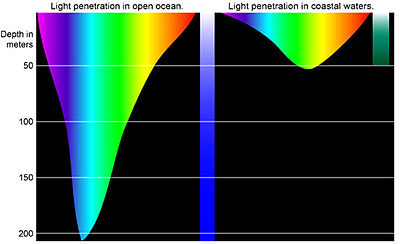
This is the light penetration of open Ocean water. Probably pure water would have greater penetration, but as you notice, the deeper you go, the bluer the light is, red light gets absorbed more easily. The good news is the light absorbed at 26 meters isn't that bad. New New York would appear a bit bluer that it otherwise would, you might lose the pink Martian sky as seen through these blocks of water.
We might want to concentrate light on the city to produce Earth Normal levels.
A diffraction lens might work best for this.
I would have to modify the design of this city to concentrate light at Earth normal levels: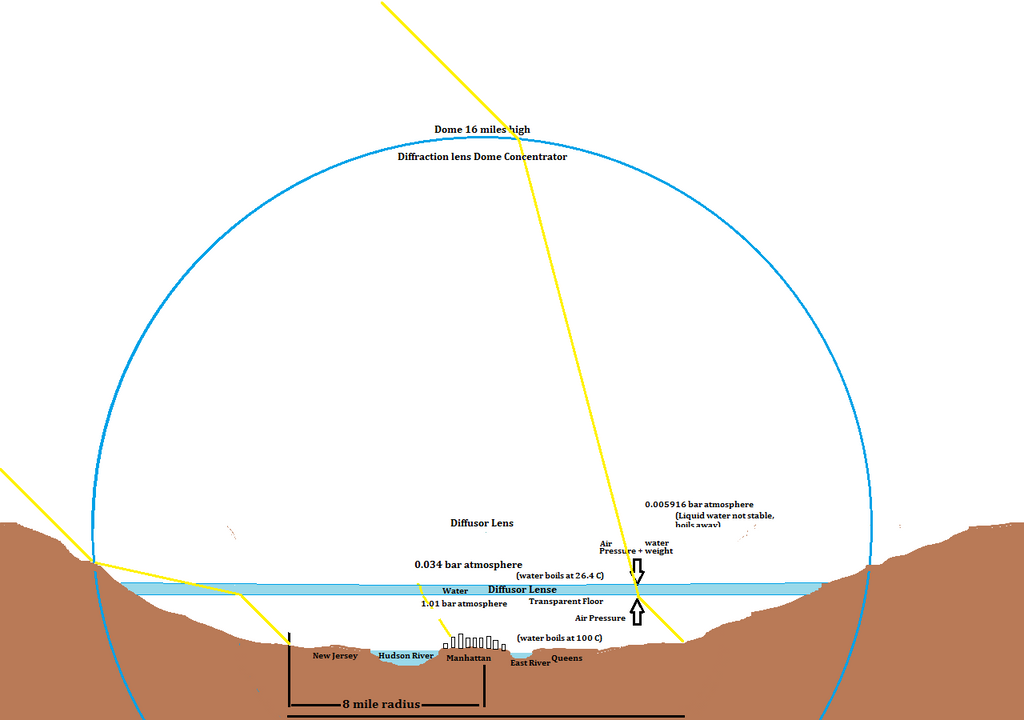
The outer dome consists of diffraction lenses, the lenses' surface surface is adjusted to track the Sun as it moves across the sky in order to concentrate sunlight on the water diffusion lense below, adjusting the sunlight intensity till it reaches about 1380 watts per meter squared.
Or else we can just lay down a huge array of photovoltaic cells around the dome and then generate the internal sunlight artificially. I suppose if Mars gets 800 watts per meter squared of sunlight and the photovoltaic cells convert sunlight to electricity with 15% efficiency, that would produce 120 watts per meter squared, we would need 11.5 square meters of photovoltaics to produce 1380 watts, the square root of 11.5 is 3.39, so for a 8 mile radius circle, we'll need a circle about 30 miles in radius to collect the solar energy to reproduce the sunlight needed under the dome, but since the dome receives half that in natural sunlight, we would just have to convert that electricity back into artificial sunlight with 50% efficiency to produce daylight levels of sunlight under the dome.
Seems to me that a photovoltaic array 30 miles in diameter would be easier to build than s dome 16 miles high.
Last edited by Tom Kalbfus (2016-01-06 09:46:36)
Offline
Like button can go here
#18 2016-01-06 17:03:40
- Terraformer
- Member
- From: The Fortunate Isles
- Registered: 2007-08-27
- Posts: 3,988
- Website
Re: New New York
Replicating New York on Mars would hardly be "new", would it? New York isn't a copy of York.
I still don't understand why you'd replicate New York on Mars, instead of building a new city that takes all the best features of Terran urban design...
Use what is abundant and build to last
Offline
Like button can go here
#19 2016-01-06 22:12:32
- SpaceNut
- Administrator
- From: New Hampshire
- Registered: 2004-07-22
- Posts: 30,107
Re: New New York
I suggested less pressure in order to reduce the amount of water which makes the problem go away for the levels of light reaching the surface. Concentration via frensel lensing is a good way to reduce the size of the dome as well.
Offline
Like button can go here
#20 2016-01-07 09:51:58
- Tom Kalbfus
- Banned
- Registered: 2006-08-16
- Posts: 4,401
Re: New New York
Replicating New York on Mars would hardly be "new", would it? New York isn't a copy of York.
I still don't understand why you'd replicate New York on Mars, instead of building a new city that takes all the best features of Terran urban design...
One reason is New York City is an unplanned city, it evolved over time according to people's needs.
So what happens if you just replicate the unplanned city and just fix its most obvious shortcomings? A totally planned city is going to have some very big omissions and mistakes, because the planned city never had to function in the real world before it was built. Also this is a shortcut for me, it is easier to talk about an existing city and discuss what would have to change it was built on Mars, than for me to devise a totally planned city from the ground up. That way someone in this discussion can bring up something I haven't even thought of based on his knowledge of the original New York City. For instance, there is a cruise ship terminal on the Manhattan side of the Hudson River, if we replicated that, the Cruise ships wouldn't have anywhere to go, other than up and down the Hudson or maybe the East River. I don't think the Metro-North Railroad tracks would see much use for example. You could go from Grand Central Station to 125th street I suppose.
Just look at what would be under this dome if we duplicated it on Mars. We have most of Manhattan, the East River is cut off at where the Henry Hudson Bridge would be, so you couldn't quite operate the Circle Line. We have the Hudson River, the East River, this circle includes the Statue of Liberty, Governor's Island, a good slice of New Jersey, A large portion of Queens, and Brooklyn. I think a lot of the fire escapes will have to be rethought. One can jump from the third story of a building and land on his feet unharmed. I could imagine street gangs jumping over alleyways from the roofs of buildings. Low gravity does have its temptations after all!
Offline
Like button can go here
#21 2016-01-07 19:51:33
- SpaceNut
- Administrator
- From: New Hampshire
- Registered: 2004-07-22
- Posts: 30,107
Re: New New York
All we neewd now is the cement mixer and then some to begin building as the Researchers Mix Up Batches Of Martian Concrete
The good news is that it is made with no water and the bad is its going to smell like oh a rotting egg, ya the binding ingredient is sulfur....
Offline
Like button can go here
#22 2016-01-08 10:36:29
- Tom Kalbfus
- Banned
- Registered: 2006-08-16
- Posts: 4,401
Re: New New York
All we neewd now is the cement mixer and then some to begin building as the Researchers Mix Up Batches Of Martian Concrete
The good news is that it is made with no water and the bad is its going to smell like oh a rotting egg, ya the binding ingredient is sulfur....
The thing is, if you took your helmet off to take a sniff, you'd die. Perhaps you don't want any of the surfaces exposed to an oxygen atmosphere. You wouldn't use any of this stuff for anything under the dome. As for the New New York Dome, I suppose one could use water from the polar caps. There should be enough water to fill the Hudson, East River and Long Island Sound on this map. We could probably import some water from the asteroid belt as well, though I don't think we would need to for this project. It is just one dome, a tiny fraction of the planet's surface, the scale is much smaller than any terraforming project, and we could have a breathable atmosphere under the dome sooner than we could terraform Mars. People could walk around and live their lives under this dome, just as they could on Earth, but with a little more bounce in their step due to low gravity.
I also think, where ever a road meets the wall of this dome, we could add an airlock for cars. Cars would pass through this airlock to travel outside. I think Mars cars would be larger than their terrestrial counterparts, because we would need room for airlocks, and bathroom facilities, and perhaps a small kitchen as well. It would be a real drag to have to put on a space suit in order to make a pit stop for a bathroom break while traveling on those outside Martian highways!
Last edited by Tom Kalbfus (2016-01-08 10:40:01)
Offline
Like button can go here
#23 2016-01-08 21:01:53
- SpaceNut
- Administrator
- From: New Hampshire
- Registered: 2004-07-22
- Posts: 30,107
Re: New New York
I agree that a door would be greatly appreciated as how else can we explore Mars resources that are not under the dome.....
Offline
Like button can go here
#24 2016-01-10 12:07:08
- Tom Kalbfus
- Banned
- Registered: 2006-08-16
- Posts: 4,401
Re: New New York
The real trick would be designing the airlocks so they don't slow down traffic as cars pass through them. Roads would have to be wider to accommodate the larger Martian cars. People would actually have to live in them, while traveling on the Martian "Outback"!
Offline
Like button can go here
#25 2016-01-10 12:48:39
- Terraformer
- Member
- From: The Fortunate Isles
- Registered: 2007-08-27
- Posts: 3,988
- Website
Re: New New York
Or you could just store your cars on the edge of the city...
Use what is abundant and build to last
Offline
Like button can go here
